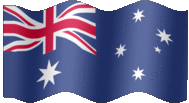|
|
||
 |
Jay & Nicole Visit Australia (click any picture for enlargement) |
|
|
|
||
|
This chapter of our Australian trip begins with Nicole & I leaving Caloundra and heading north towards Bundaberg. Our goal for today was Rainbow Beach, which should be an easy 5 hour drive. |
||
|
|
||
| The weather was beautiful and the road was in good condition... although no longer a real highway. On both sides were miles of managed forests, planted for use by the local paper mills. | ||
|
|
||
| <==
Most intersections weren't on the map ... so we followed the GPS ... which led us to
dirt roads and hours
of slow driving :(
|
||
|
|
||
| Looking to the left we could see a flat, wide-open beach with light sand and only a few people. | ||
|
|
||
| The wide beach continued to the right. In the background we could see large hills. | ||
|
|
||
|
|
||
|
Looking more to the right ... we could see the colorful sand dunes that make this place famous. |
||
|
|
||
| The
Kabi, another Aboriginese group, have a story about their god of rainbows ...
who was fighting an evil force and dove into the hillside for protection ...
thus making the special colors. There is supposed to be seven kinds of sand in the dunes, all eroded from the area's various mineral deposits. |
||
|
|
||
|
A pair of puppies were fun to watch, but no one swam since the storm currents were so bad. |
||
|
|
||
|
The next day we took a long walk along the beach ... the water had a very nice blue color. |
||
|
|
||
| The
beach area was created by erosion of the big sand dunes.
Recently the erosion was getting much worse. To keep tourists from causing more trouble, they built a series of wooden paths and steps. |
||
|
|
||
|
When we got close to the waves, we could see why the lifeguards were not allowing anyone to swim. The foam from the crashing waves sloshed around like in a giant wash machine. |
||
|
|
||
|
At times the beach narrowed down to almost nothing and we had to walk in the water. |
||
|
|
||
|
The sand is classified as protected property, so we could not take any samples with us. |
||
|
|
||
|
The black sandstone is made of a heavy volcanic material that has eroded away more slowly. |
||
|
|
||
|
These pictures show rocks in various levels of erosion; they will all end up as sand! |
||
|
|
||
| These
plants put down deep roots, but are quite helpless when the underlying dune is eroded
away.
They slowly slide to the beach and ultimately get washed into the ocean. |
||
|
|
||
|
Does something
look |
This version shows the interesting optical illusion. |
We decided to say goodbye to Rainbow Beach and move on. |
|
|
||
| Our
next destination was the Bundaberg area, which was about a 4 hour drive away.
We will soon be encountering a climatic change, as the Great Barrier Reef will be protecting the coast ... but we didn't know if we'd see the difference. |
||
|
|
||
| Within a
few hours, the land became flat and greener, with fields of sugar cane ...
which can only grow in a wet climate.
We came to the big city of Bundaberg and stopped for a quick burger; we used their internet to do research on places to stay in the area. |
||
|
|
||
| Bundaberg is a major processing center for sugar cane and has a famous rum distillery. We took a tour, but were disappointed at the lack of samples ... they are serious about "no drinking & driving"! | ||
|
|
||
|
|
||
|
We drove to the coast and found a beachfront campground next to the Mon Repos turtle reserve. |
||
|
|
||
|
We relaxed and read more about the area. It turns out that we were on the longitudinal line called the 'Tropic of Capricorn' ... ... which means on Dec 21st, (summer solstice in the southern hemisphere), the sun would be directly overhead at noon. |
||
|
|
||
|
A lorikeet sat above us in a pine tree, dropping needles down ... they probably get bugs/sap from the tree, but they make a mess. |
There we no boring birds, even the pigeons looked pretty cool. |
|
|
|
||
|
The female
turtles return to the same beach after roaming the oceans for 20
years. They lay a couple nests of 200 eggs each and then depart.
If the eggs don't get eaten by predators or trampled by humans, they will
hatch and the baby turtles scamper to the ocean; then they need to worry
about birds and sea creatures. Only 1% of them make it to adulthood,
which is why they are endangered. |
||
|
|
||
|
|
||
|
|
||
|
|
||